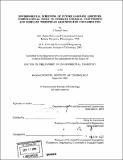Environmental screening of future gasoline additives : computational tools to estimate chemical partitioning and forecast widespread groundwater contamination
Author(s)
Arey, J. Samuel (Jeremy Samuel), 1975-
DownloadFull printable version (13.68Mb)
Other Contributors
Massachusetts Institute of Technology. Dept. of Civil and Environmental Engineering.
Advisor
Philip M. Gschwend.
Terms of use
Metadata
Show full item recordAbstract
(cont.) application of Raoult's law for the same set of systems. An approach was developed which relates the empirical LSER solute polarity parameter, pi2Ĥ, to two more fundamental quantities: a polarizability term and a computed solvent accessible surface electrostatic term. Electrostatics computations employed dielectric field continuum models and a density functional theory (B3LYP) or efficient Hartree-Fock (HF/MIDI!) method for 90 polar and nonpolar organic solutes. Predicted pi2Ĥ values had a correlation coefficient of 0.95 and standard deviation of 0.11 relative to empirically measured values. The resulting model relies on only two fitted coefficients and has the additional advantage of potential applicability to any solute composed of C, H, N, O, S, F, C1, and Br. Fuel formulations evolve continually, and historical experience with the fuel additives tetra-ethyl lead and methyl-tert-butyl ether (MTBE) indicates that newly proposed additives should be screened for their potential to threaten environmental resources, before they are used widely. A physical-chemical transport model was developed to forecast well water concentrations and transport times for gasoline components migrating from underground fuel tank releases to vulnerable community water supply wells. Transport calculations were parameterized using stochastic estimates of representative fuel release volumes and hydrogeologic characteristics, and were tailored to individual compounds based on their abundances in gasoline, gasoline-water partition coefficients, and organic matter-water partition coefficients. With no calibration, the screening model successfully captured the reported magnitude of MTBE contamination of at-risk community supply wells. To estimate gasoline-water partition coefficients for unstudied solutes, we combined linear solvation energy relationships (LSERs) developed for pure 1:1 systems using linear solvent strength theory and a "solvent compartment" model. In this way, existing LSERs could be extended to treat solute partitioning from gasoline, diesel fuel, and similar mixtures into contacting aqueous mixtures. This allowed prediction of liquid-liquid partition coefficients in a variety of fuel-water systems for a broad range of dilute solutes. When applied to 37 polar and nonpolar solutes partitioning between an aqueous mixture and 12 different fuel-like mixtures (many including oxygenates), the estimated model error was a less than a factor of 2 in the partition coefficient. This was considerably more accurate than
Description
Thesis (Ph. D.)--Massachusetts Institute of Technology, Dept. of Civil and Environmental Engineering, 2004. "September 2004." Includes bibliographical references.
Date issued
2004Department
Massachusetts Institute of Technology. Department of Civil and Environmental EngineeringPublisher
Massachusetts Institute of Technology
Keywords
Civil and Environmental Engineering.
